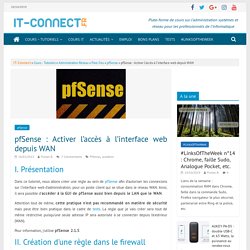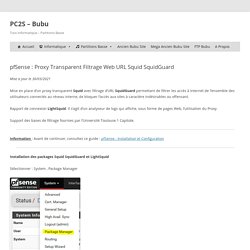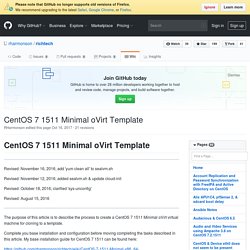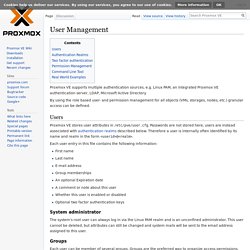

PfSense : Activer l'accès à l'interface web depuis WAN. I.

Présentation Dans ce tutoriel, nous allons créer une règle au sein de pfSense afin d'autoriser les connexions sur l'interface web d'administration, pour un poste client qui se situe dans le réseau WAN. Ainsi, il sera possible d'accéder à la GUI de pfSense aussi bien depuis le LAN que le WAN.
Attention tout de même, cette pratique n'est pas recommandé en matière de sécurité mais peut être bien pratique dans le cadre de tests. La règle que je vais créer sera tout de même restrictive puisqu'une seule adresse IP sera autorisée à se connecter depuis l'extérieur (WAN). Pour information, j'utilise pfSense 2.1.5. II. Connectez-vous à l'interface d'administration pfSense, depuis le LAN.
Accédez au menu Firewall puis Rules. Au niveau des règles, placez-vous dans l'onglet "WAN" et cliquez sur le bouton en bas à droite pour créer une nouvelle règle. Le paramétrage de la règle, c'est là que tout se joue ! - Action : "Pass" car on souhaite créer une règle pour autoriser du trafic. PfSense : Proxy Transparent Filtrage Web URL Squid SquidGuard. Mise en place d’un proxy transparent Squid avec filtrage d’URL SquidGuard permettant de filtrer les accès à Internet de l’ensemble des utilisateurs connectés au réseau interne, de bloquer l’accès aux sites à caractère indésirables ou offensant.

Rapport de connexion LightSquid. Il s’agit d’un analyseur de logs qui affiche, sous forme de pages Web, l’utilisation du Proxy. Support des bases de filtrage fournies par l’Université Toulouse 1 Capitole. Important : Une autre possibilité de filtrage est possible avec pfSense : pfBlockerNG devel – Protection Contre La Publicité et le Tracage avec Filtrage Web.
CentOS 7 1511 Minimal oVirt Template · rharmonson/richtech Wiki. CentOS 7 1511 Minimal oVirt Template Revised: November 16, 2016; add 'yum clean all' to sealvm.sh Revised: November 12, 2016; added sealvm.sh & update cloud-init Revised: October 18, 2016; clarified 'sys-unconfig' Revised: August 15, 2016 The purpose of this article is to describe the process to create a CentOS 7 1511 Minimal oVirt virtual machine for cloning to a template.

Complete you base installation and configuration before moving completing the tasks described in this article. Process Update hostnameClear machine-id; deletion is problematic next bootDelete SSH host keysReplace ifcfg-eth0 PREFIX with NETMASKEdit ifcfg-eth0 to remove unnecessary values including HWADDDelete logsInstall ovirt-guest-agent-commonComplete any additional desired configurations or installations. Execute Update the hostname to something generic (optional) Clear the machine-id. [root@centos7 ~]# > /etc/machine-id Clear host SSH keys and /root/. ###Network Interface TYPE=Ethernet DEVICE=eth0 ONBOOT=yes BOOTPROTO=dhcp. Activer l'ipv6 pour des VM proxmox. » how-to.ovh. User Management in Proxmox. Proxmox VE authentication server This is a unix like password store (/etc/pve/priv/shadow.cfg).

Password are encrypted using the SHA-256 hash method. Users are allowed to change passwords. Terms and Definitions Users A Proxmox VE user name consists of 2 parts: <userid>@<realm>. We store the following attribute for users (/etc/pve/user.cfg): first namelast nameemail addressexpiration dateflag to enable/disable accountcommentSuperuser The traditional unix superuser account is called ‘root@pam’.
Groups Each user can be member of several groups. Objects and Paths Access permissions are assigned to objects, such as a virtual machines (/vms/{vmid}) or a storage (/storage/{storeid}) or a pool of resources (/pool/{poolname}). Privileges A privilege is the right to perform a specific action. User Management. In order for a user to perform an action (such as listing, modifying or deleting a parts of a VM configuration), the user needs to have the appropriate permissions.

Proxmox VE uses a role and path based permission management system. An entry in the permissions table allows a user or group to take on a specific role when accessing an object or path. This means an such an access rule can be represented as a triple of (path, user, role) or (path, group, role), with the role containing a set of allowed actions, and the path representing the target of these actions. Roles A role is simply a list of privileges.
Administrator: has all privileges NoAccess: has no privileges (used to forbid access) PVEAdmin: can do most things, but miss rights to modify system settings (Sys.PowerMgmt, Sys.Modify, Realm.Allocate). You can see the whole set of predefined roles on the GUI. Adding new roles can currently only be done from the command line, like this: Proxmox VE API Documentation. Proxmox - management of instances in Proxmox VE cluster — Ansible Documentation.
Proxmox - management of instances in Proxmox VE cluster — Ansible Documentation. Telegraf/DATA_FORMATS_INPUT.md at master · papamatheo/telegraf.